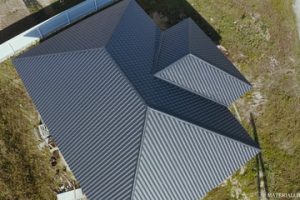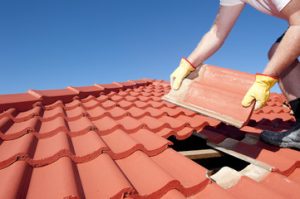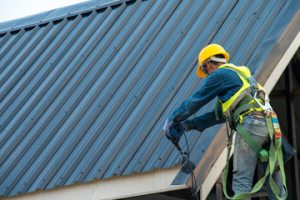Metal roofs are an excellent choice for homes, offering durability and energy efficiency while adding value to the property. However, a professional Erie Roofing Company installation is required to ensure that the project goes smoothly.
In this blog post, we will discuss what to expect during a professional metal roof installation. We will also cover some tips on preparing your home or building, as well as what to look for in a good contractor.

Preparation
Often, metal roofs are installed over existing asphalt shingles or a wood substrate. When this is the case, proper preparation is critical to a smooth and effective installation that maximizes function and longevity.
Start by inspecting the condition of the existing shingles and replacing any damaged areas to provide a sound foundation for your new roof. This helps to prevent problems from developing in the future.
Next, roll out a layer of underlayment, which serves as a moisture barrier between the existing shingles and the new metal sheets. If needed, install furring strips to help level uneven spots on the roof. Once the underlayment is in place, install ridge cap to align and seal the roof peak.
Then, if desired, install heat cables to reduce the risk of ice dams in cold weather and protect the roof from water damage. Plan cable layout carefully to ensure they will effectively cover areas that are prone to ice dams, such as roof valleys and eaves.
Finally, if necessary, install flashing to seal around chimneys, vents, and other penetrations. Once all the preparation is in place, your installer can begin laying down the metal sheets. They will work in sections, starting at the bottom of the roof and working their way up, ensuring a seamless finish and preventing leaks. When the sheets are in place, the installer will perform a final inspection to ensure the work meets industry standards and is completed to your satisfaction.
Installation
The installation phase includes putting up metal sheets, trims, and accessories to form a protective covering. Contractors will measure the roof to determine how much material is needed, and then cut it to size. They will also lay down underlayment, which acts as a barrier between your roof and the metal sheets. It’s a good idea to have an extra pair of hands around during this process, as safety is a top priority when working up high with potentially dangerous tools.
The installer will install clips along the seams of each panel to hold it securely in place. The right clips are crucial to standing seam metal roofing, as they allow panels to expand and contract with temperature changes, preventing warping, oil canning, and premature failure. They will also use the proper fasteners to secure the roof and prevent leaks. For the best results, fasteners should be a color that matches the metal roof’s finish.
Finally, the installer will install flashing to protect areas around roof penetrations such as chimneys, vents, and pipes. These are the most vulnerable parts of a metal roof, and they can often be prone to leaks and corrosion. The installer will seal these with butyl tape and caulking to prevent water damage.
When the project is finished, the installer will clean up and remove all debris from your property. They’ll also give you a 48-hour window to evaluate the work and ensure that it meets your standards.
Inspection
Professional metal roofing contractors understand the intricacies involved with the installation of standing seam metal roof panels. A thorough understanding of these details results in faster job site efficiency, better product performance, and greater customer satisfaction.
Unlike traditional shingles, metal roofs require a lot more attention to detail during installation. From substrate preparation to panel placement, there are a number of potential problems that may arise without the proper care. This is why hiring a qualified contractor is crucial. A professional will take the time to ensure that all steps are completed correctly, resulting in a long-lasting and beautiful metal roof.
Once the project is complete, a contractor will conduct a full inspection of the finished product. This is a good opportunity for you to address any concerns that you have, as well as for the contractor to explain any warranties that are available.
It is important to note that a metal roof should be inspected regularly for damage or wear and tear. Regular inspections can help to prevent costly repairs down the road. In addition to checking for loose fasteners and rust spots, the inspection process should include a check of all roof penetrations, flashing, and sealants.
During the inspection phase, it is recommended that you try to avoid hovering over the workers as much as possible. This is a large-scale construction project that involves working up high with dangerous tools and materials. It is a good idea to have an adult present at all times, and it is best that you use the right safety gear (gloves, safety glasses, and sturdy shoes or boots). It is also a good idea to make sure that any lawn ornaments or pots that were moved during the installation are put back in their original places upon completion.
Final Touches
Metal roofing adds durability, functionality, and aesthetic appeal to residential and commercial buildings. To ensure your new roof functions as intended and looks its best, it’s important to work with a professional contractor with experience in the field. A reputable roofing contractor will be transparent about their process and pricing, and provide detailed contracts that include warranties for materials and labor.
It’s essential to carefully inspect the installation site before starting any work. The condition of the existing shingles must be evaluated, and any areas with damage or gaps need to be repaired. Loose shingles can easily be dislodged by high winds or rain, which can cause water infiltration and potential mold or mildew growth.
A skilled metal roofing contractor will properly install the underlayment, which is critical for waterproofing and insulation. They’ll follow the manufacturer’s guidelines for laying the underlayment, and make sure it’s securely fastened to the OSB roof deck.
Finally, they’ll install any necessary trim and edging pieces to protect the edges of the roof and give it a polished look. These pieces are usually made of aluminum or copper. Both are durable metals that resist corrosion and have beautiful, natural colors that evolve over time.
Before you agree to a contract, ask your contractor for a 48-hour window to evaluate the roof and its surroundings, and discuss any issues that need to be addressed. This can also be a good opportunity to ask any questions you have about the installation.

